Environmental Difference and Spatial Distance Affect the Fidelity of Variation Source of Microbial Community Structure in Air-Dried Soils
Abstract
:1. Introduction
2. Materials and Methods
2.1. Soil Sampling
2.2. Environmental Variables Determination
2.3. DNA Extraction and High-Throughput Sequencing
2.4. Bioinformatic Analysis
2.5. Statistical Analysis
3. Results
3.1. General Description of Soil Microbial Community Composition
3.2. Decline of EP in Air-Dried Soils Compared with That in Fresh Soils
3.3. NDEP Varies with Spatial Distance and Environmental Difference
3.4. The Main Environmental Variables Influencing NDEP
3.5. OTUs Differential Abundance Analysis between Fresh Soils and Air-Dried Soils
4. Discussions
5. Conclusions
Supplementary Materials
Author Contributions
Funding
Data Availability Statement
Acknowledgments
Conflicts of Interest
References
- Dolfing, J.; Feng, Y. The importance of soil archives for microbial ecology. Nat. Rev. Microbiol. 2015, 13, 1. [Google Scholar] [CrossRef]
- Liu, J.; Guo, Z.; Xu, A.; Wang, C.; Wu, S.; Liu, Y.; Pan, K.; Zhang, F.; Pan, X. Consistent spatial distribution patterns of bacterial communities revealed by serial time-archived soils from long-term field experiments. Soil Biol. Biochem. 2019, 133, 137–145. [Google Scholar] [CrossRef]
- Wang, F.; Che, R.; Deng, Y.; Wu, Y.; Tang, L.; Xu, Z.; Wang, W.; Liu, H.; Cui, X. Air-drying and long time preservation of soil do not significantly impact microbial community composition and structure. Soil Biol. Biochem. 2021, 157, 108238. [Google Scholar] [CrossRef]
- Liang, Y.; Ning, D.; Lu, Z.; Zhang, N.; Hale, L.; Wu, L.; Clark, I.M.; McGrath, S.P.; Storkey, J.; Hirsch, P.R.; et al. Century long fertilization reduces stochasticity controlling grassland microbial community succession. Soil Biol. Biochem. 2020, 151, 108023. [Google Scholar] [CrossRef]
- Knapp, C.W.; Dolfing, J.; Ehlert, P.A.; Graham, D.W. Evidence of increasing antibiotic resistance gene abundances in archived soils since 1940. Environ. Sci. Technol. 2010, 44, 580–587. [Google Scholar] [CrossRef] [PubMed]
- Potts, M. Desiccation tolerance of prokaryotes. Microbiol. Rev. 1994, 58, 755–805. [Google Scholar] [CrossRef]
- Kakumanu, M.L.; Cantrell, C.L.; Williams, M.A. Microbial community response to varying magnitudes of desiccation in soil: A test of the osmolyte accumulation hypothesis. Soil Biol. Biochem. 2013, 57, 644–653. [Google Scholar] [CrossRef]
- Dadenko, E.V.; Kazeev, K.S.; Kolesnikov, S.I.; Val’kov, V.F. Changes in the enzymatic activity of soil samples upon their storage. Eurasian Soil Sci. 2009, 42, 1380–1385. [Google Scholar] [CrossRef]
- Benucci, G.M.N.; Rennick, B.; Bonito, G. Patient propagules: Do soil archives preserve the legacy of fungal and prokaryotic communities? PLoS ONE 2020, 15, e0237368. [Google Scholar] [CrossRef] [PubMed]
- Ge, Y.; He, J.Z.; Zhu, Y.G.; Zhang, J.B.; Xu, Z.; Zhang, L.M.; Zheng, Y.M. Differences in soil bacterial diversity: Driven by contemporary disturbances or historical contingencies? ISME J. 2008, 2, 254–264. [Google Scholar] [CrossRef] [PubMed] [Green Version]
- Chen, R.; Zhong, L.; Jing, Z.; Guo, Z.; Li, Z.; Lin, X.; Feng, Y. Fertilization decreases compositional variation of paddy bacterial community across geographical gradient. Soil Biol. Biochem. 2017, 114, 181–188. [Google Scholar] [CrossRef]
- Deng, Y.; He, Z.; Xiong, J.; Yu, H.; Xu, M.; Hobbie, S.E.; Reich, P.B.; Schadt, C.W.; Kent, A.; Pendall, E.; et al. Elevated carbon dioxide accelerates the spatial turnover of soil microbial communities. Glob. Change Biol. 2016, 22, 957–964. [Google Scholar] [CrossRef]
- Shi, Y.; Li, Y.; Xiang, X.; Sun, R.; Yang, T.; He, D.; Zhang, K.; Ni, Y.; Zhu, Y.-G.; Adams, J.M.; et al. Spatial scale affects the relative role of stochasticity versus determinism in soil bacterial communities in wheat fields across the North China Plain. Microbiome 2018, 6, 27. [Google Scholar] [CrossRef] [PubMed]
- Shade, A.; Jones, S.E.; Caporaso, J.G.; Handelsman, J.; Knight, R.; Fierer, N.; Gilbert, J.A. Conditionally Rare Taxa Disproportionately Contribute to Temporal Changes in Microbial Diversity. Mbio 2014, 5, e01371-14. [Google Scholar] [CrossRef] [PubMed] [Green Version]
- Fick, S.E.; Hijmans, R.J. WorldClim 2: New 1-km spatial resolution climate surfaces for global land areas. Int. J. Climatol. 2017, 37, 4302–4315. [Google Scholar] [CrossRef]
- Stubner, S. Enumeration of 16S rDNA of Desulfotomaculum lineage 1 in rice field soil by real-time PCR with SybrGreen (TM) detection. J. Microbiol. Methods 2002, 50, 155–164. [Google Scholar] [CrossRef]
- Caporaso, J.G.; Kuczynski, J.; Stombaugh, J.; Bittinger, K.; Bushman, F.D.; Costello, E.K.; Fierer, N.; Pena, A.G.; Goodrich, J.K.; Gordon, J.I.; et al. QIIME allows analysis of high-throughput community sequencing data. Nat. Methods 2010, 7, 335–336. [Google Scholar] [CrossRef] [Green Version]
- Magoč, T.; Salzberg, S.L. FLASH: Fast length adjustment of short reads to improve genome assemblies. Bioinformatics 2011, 27, 2957–2963. [Google Scholar] [CrossRef]
- Edgar, R.C. UPARSE: Highly accurate OTU sequences from microbial amplicon reads. Nat. Methods 2013, 10, 996–998. [Google Scholar] [CrossRef]
- Wang, Q.; Garrity, G.M.; Tiedje, J.M.; Cole, J.R. Naive Bayesian classifier for rapid assignment of rRNA sequences into the new bacterial taxonomy. Appl. Environ. Microbiol. 2007, 73, 5261–5267. [Google Scholar] [CrossRef] [Green Version]
- R Core Team. R: A Language and Environment for Statistical Computing; R Foundation for Statistical Computing: Vienna, Austria, 2010. [Google Scholar]
- Anderson, M.J. Permutational Multivariate Analysis of Variance (PERMANOVA). In Wiley StatsRef: Statistics Reference Online; John Wiley & Sons, Ltd.: Hoboken, NJ, USA, 2017. [Google Scholar]
- Philip, D. VEGAN, a package of R functions for community ecology. J. Veg. Sci. 2003, 14, 927–930. [Google Scholar]
- Feng, Y.; Chen, R.; Stegen, J.C.; Guo, Z.; Zhang, J.; Li, Z.; Lin, X. Two key features influencing community assembly processes at regional scale: Initial state and degree of change in environmental conditions. Mol. Ecol. 2018, 27, 5238–5251. [Google Scholar] [CrossRef] [PubMed]
- Martí, E.; Càliz, J.; Montserrat, G.; Garau, M.A.; Cruañas, R.; Vila, X.; Sierra, J. Air-drying, cooling and freezing for soil sample storage affects the activity and the microbial communities from two mediterranean soils. Geomicrobiol. J. 2012, 29, 151–160. [Google Scholar] [CrossRef]
- Fierer, N.; Schimel, J.P.; Holden, P.A. Influence of drying–rewetting frequency on soil bacterial community structure. Microb. Ecol. 2003, 45, 63–71. [Google Scholar] [CrossRef]
- Liu, Y.; Yao, H.; Huang, C. Assessing the effect of air-drying and storage on microbial biomass and community structure in paddy soils. Plant Soil 2009, 317, 213–221. [Google Scholar] [CrossRef]
- Dolfing, J.; Vos, A.; Bloem, J.; Ehlert, P.A.I.; Naumova, N.B.; Kuikman, P.J. Microbial diversity in archived soils. Science 2004, 306, 813. [Google Scholar] [CrossRef]
- Clark, I.M.; Hirsch, P.R. Survival of bacterial DNA and culturable bacteria in archived soils from the Rothamsted Broadbalk experiment. Soil Biol. Biochem. 2008, 40, 1090–1102. [Google Scholar] [CrossRef]
- Macdonald, C.A.; Ang, R.; Cordiner, S.J.; Horswell, J. Discrimination of soils at regional and local levels using bacterial and fungal T-RFLP profiling. J. Forensic Sci. 2011, 56, 61–69. [Google Scholar] [CrossRef]
- Liu, J.; Guo, Z.; Xu, A.; Wang, C.; Wu, S.; Pan, K.; Zhang, F.; Pan, X. Spatial differences in bacterial communities preserved in soils archived for a decade. Appl. Soil Ecol. 2019, 142, 64–71. [Google Scholar] [CrossRef]
- Martiny, J.B.; Eisen, J.A.; Penn, K.; Allison, S.D.; Horner-Devine, M.C. Drivers of bacterial beta-diversity depend on spatial scale. Proc. Natl. Acad. Sci. USA 2011, 108, 7850–7854. [Google Scholar] [CrossRef] [Green Version]
- Jiao, S.; Lu, Y. Soil pH and temperature regulate assembly processes of abundant and rare bacterial communities in agricultural ecosystems. Environ. Microbiol. 2020, 22, 1052–1065. [Google Scholar] [CrossRef] [PubMed]
- Tripathi, B.M.; Stegen, J.C.; Kim, M.; Dong, K.; Adams, J.M.; Lee, Y.K. Soil pH mediates the balance between stochastic and deterministic assembly of bacteria. ISME J. 2018, 12, 1072–1083. [Google Scholar] [CrossRef]
- Xia, Q.; Rufty, T.; Shi, W. Soil microbial diversity and composition: Links to soil texture and associated properties. Soil Biol. Biochem. 2020, 149, 107953. [Google Scholar] [CrossRef]
- Naylor, D.; DeGraaf, S.; Purdom, E.; Coleman-Derr, D. Drought and host selection influence bacterial community dynamics in the grass root microbiome. ISME J. 2017, 11, 2691–2704. [Google Scholar] [CrossRef] [PubMed] [Green Version]
- Pérez Castro, S.; Cleland, E.E.; Wagner, R.; Sawad, R.A.; Lipson, D.A. Soil microbial responses to drought and exotic plants shift carbon metabolism. ISME J. 2019, 13, 1776–1787. [Google Scholar] [CrossRef] [PubMed]
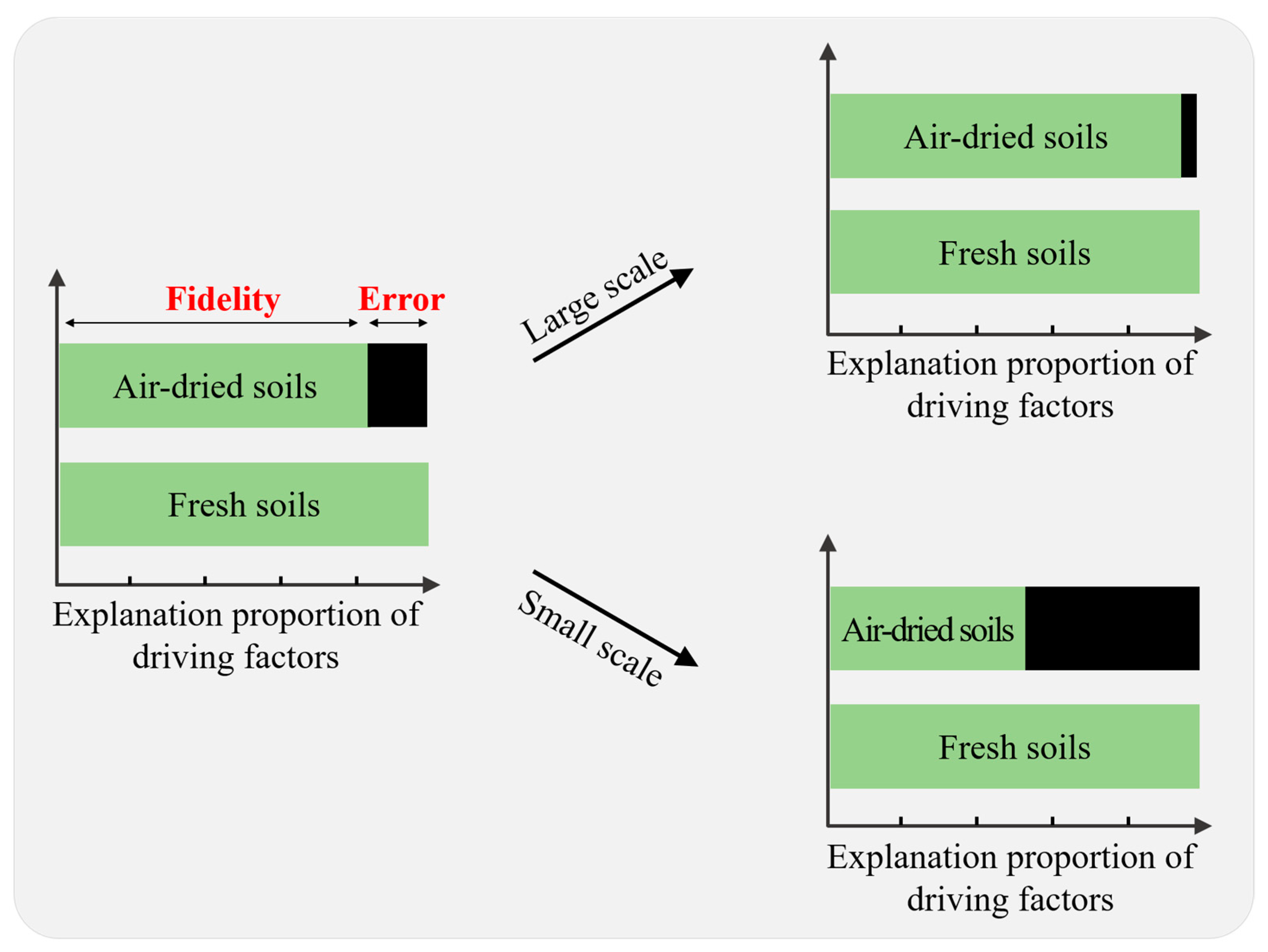
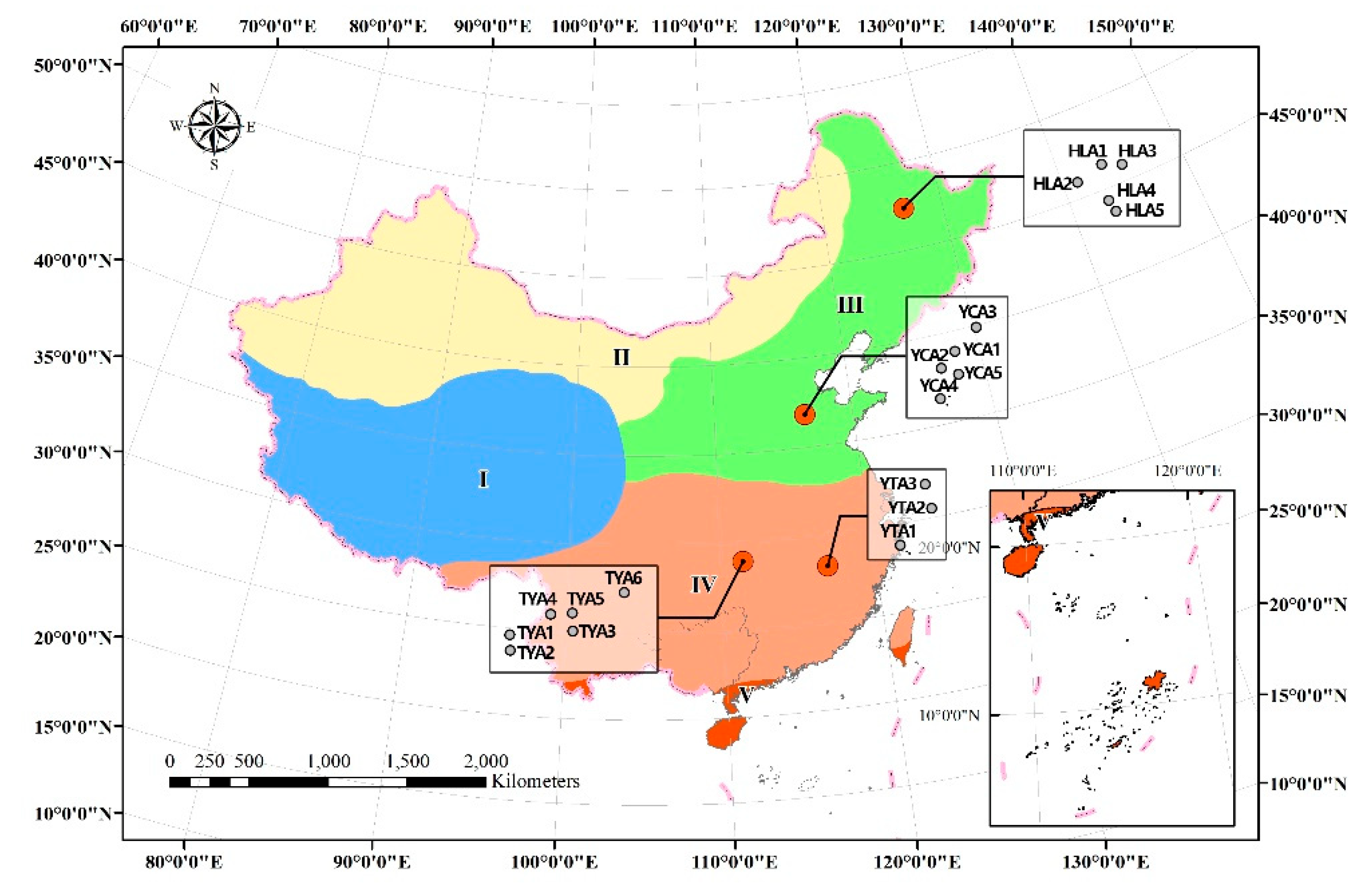
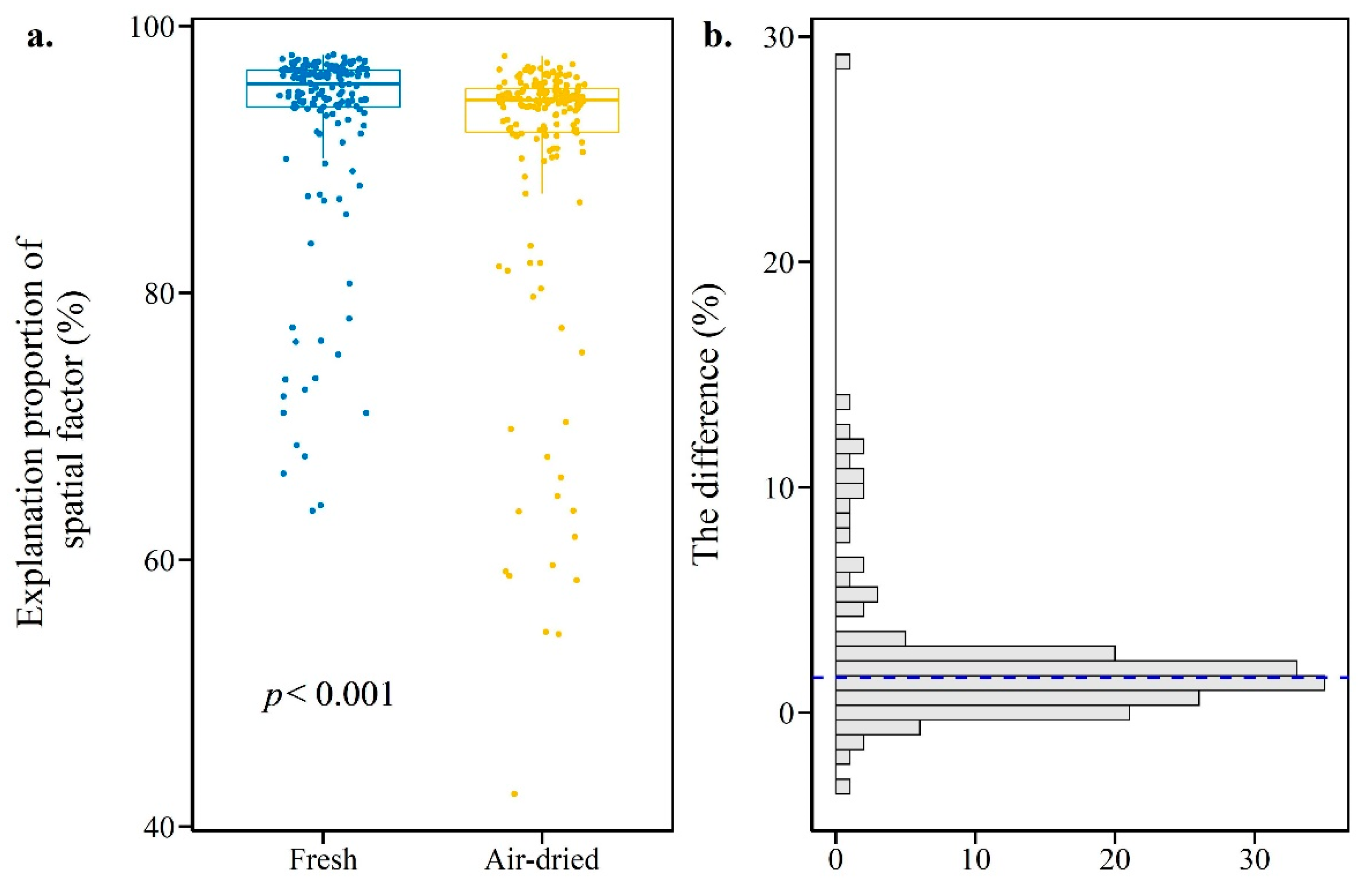
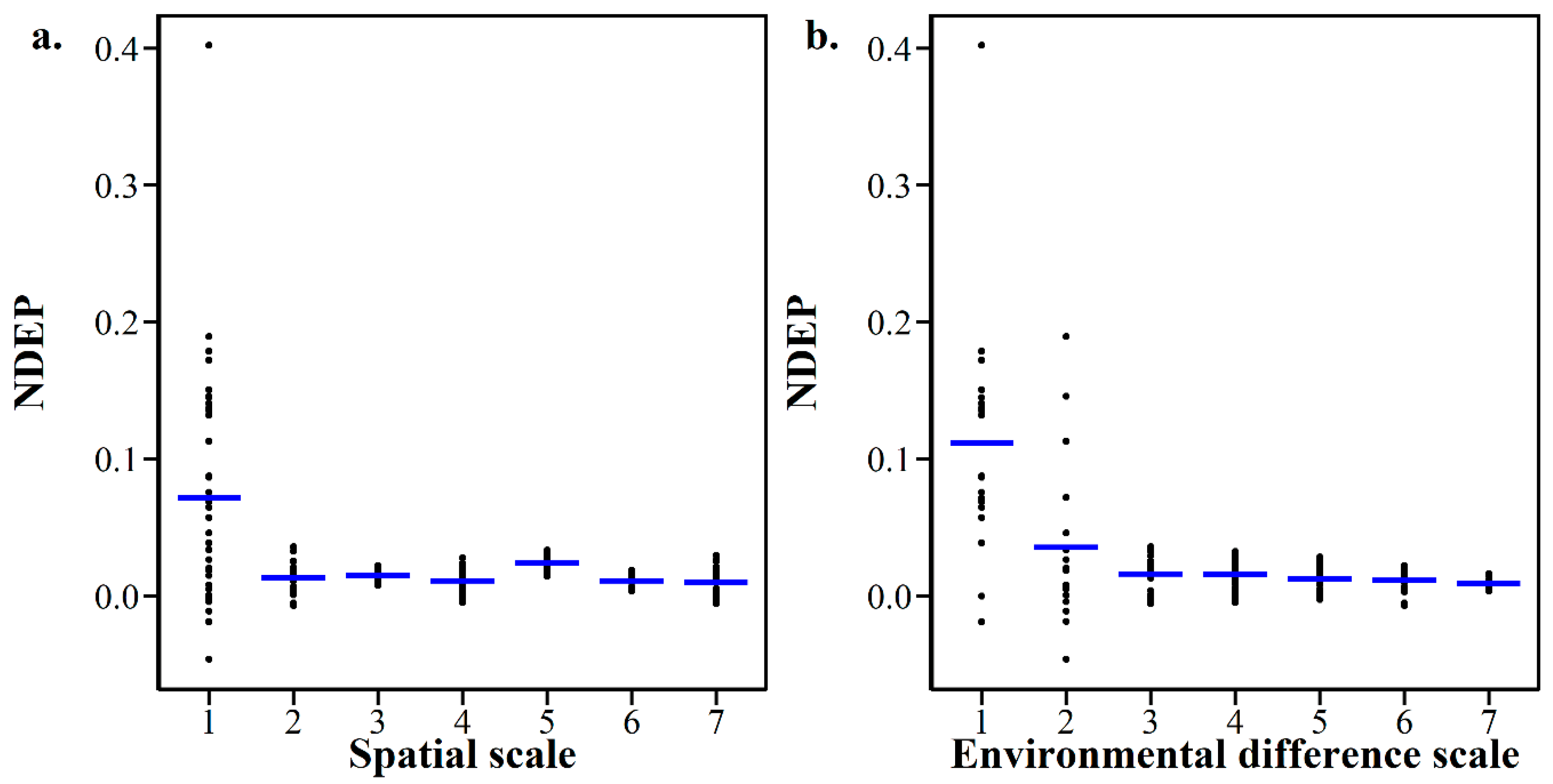

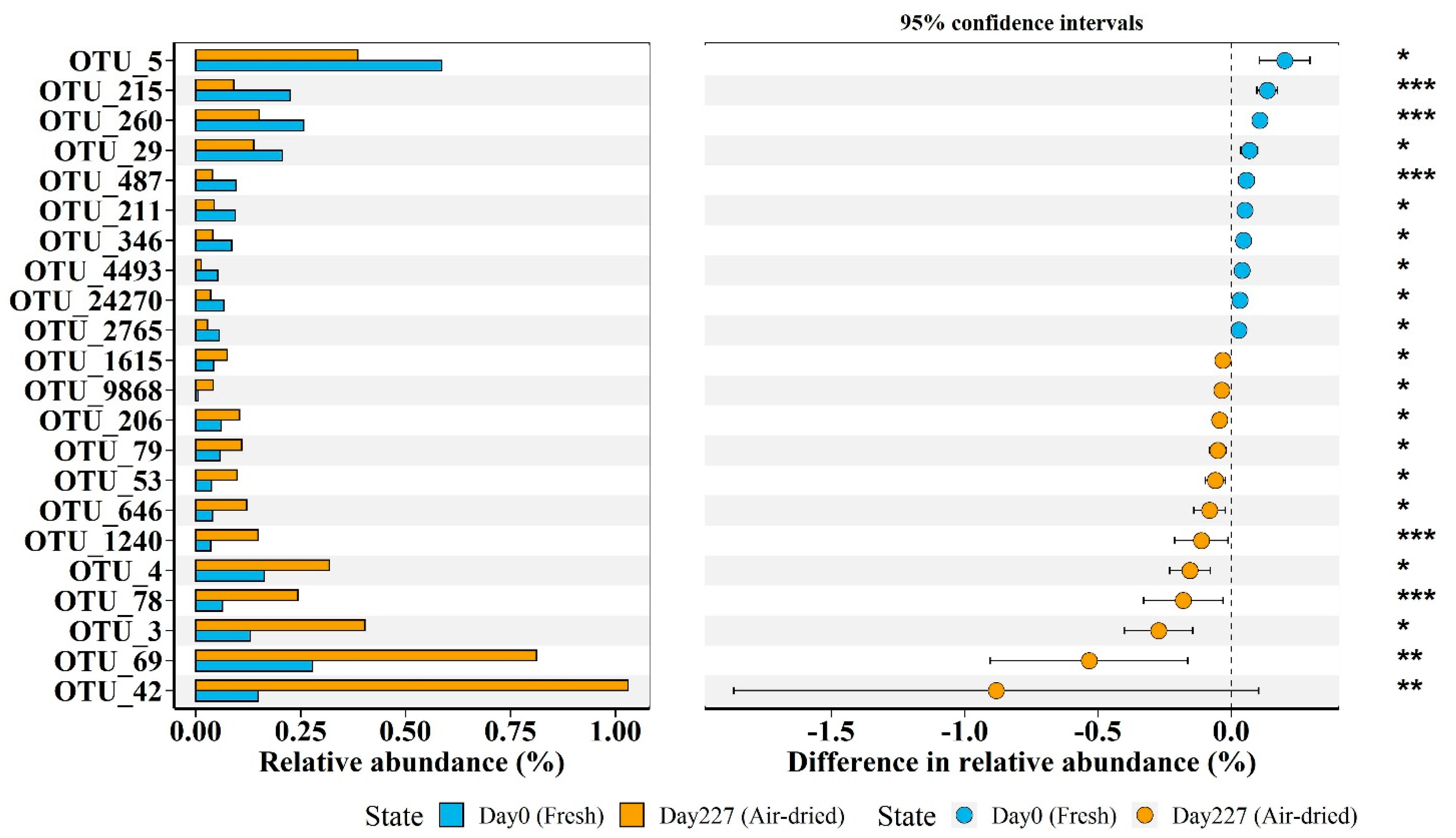
| Spatial Scale | Spatial Distance (km) | Median NDEP Values | Average NDEP Values | Number |
|---|---|---|---|---|
| 1 | 24.666 | 0.061 | 0.072 | 38 |
| 2 | 541.730 | 0.014 | 0.013 | 18 |
| 3 | 975.764 | 0.015 | 0.015 | 15 |
| 4 | 1020.115 | 0.012 | 0.011 | 30 |
| 5 | 1457.705 | 0.024 | 0.024 | 25 |
| 6 | 2305.852 | 0.012 | 0.011 | 15 |
| 7 | 2452.856 | 0.007 | 0.010 | 30 |
| Environmental Difference Scale | Environmental Difference (Euclidean) | Median NDEP Values | Average NDEP Values | Number |
| 1 | 0.577 | 0.088 | 0.112 | 19 |
| 2 | 0.945 | 0.019 | 0.036 | 17 |
| 3 | 1.324 | 0.018 | 0.016 | 27 |
| 4 | 1.535 | 0.017 | 0.016 | 44 |
| 5 | 1.772 | 0.014 | 0.012 | 26 |
| 6 | 2.061 | 0.013 | 0.012 | 26 |
| 7 | 2.450 | 0.009 | 0.009 | 12 |
| Estimate | Std. Error | t Value | p Value | Relative Effect of Estimates | |
|---|---|---|---|---|---|
| AAT | −0.03925 | 0.008156 | −4.812 | p < 0.001 | 23.67% |
| Sand | −0.05083 | 0.012719 | −3.996 | p < 0.001 | 30.66% |
| Clay | −0.04031 | 0.015062 | −2.676 | p < 0.05 | 24.31% |
| pH | −0.03542 | 0.010842 | −3.267 | p < 0.05 | 21.36% |
Publisher’s Note: MDPI stays neutral with regard to jurisdictional claims in published maps and institutional affiliations. |
© 2022 by the authors. Licensee MDPI, Basel, Switzerland. This article is an open access article distributed under the terms and conditions of the Creative Commons Attribution (CC BY) license (https://creativecommons.org/licenses/by/4.0/).
Share and Cite
Guo, Z.; Bao, Y.; Liu, J. Environmental Difference and Spatial Distance Affect the Fidelity of Variation Source of Microbial Community Structure in Air-Dried Soils. Microorganisms 2022, 10, 672. https://doi.org/10.3390/microorganisms10040672
Guo Z, Bao Y, Liu J. Environmental Difference and Spatial Distance Affect the Fidelity of Variation Source of Microbial Community Structure in Air-Dried Soils. Microorganisms. 2022; 10(4):672. https://doi.org/10.3390/microorganisms10040672
Chicago/Turabian StyleGuo, Zhiying, Yuanyuan Bao, and Jie Liu. 2022. "Environmental Difference and Spatial Distance Affect the Fidelity of Variation Source of Microbial Community Structure in Air-Dried Soils" Microorganisms 10, no. 4: 672. https://doi.org/10.3390/microorganisms10040672
APA StyleGuo, Z., Bao, Y., & Liu, J. (2022). Environmental Difference and Spatial Distance Affect the Fidelity of Variation Source of Microbial Community Structure in Air-Dried Soils. Microorganisms, 10(4), 672. https://doi.org/10.3390/microorganisms10040672






